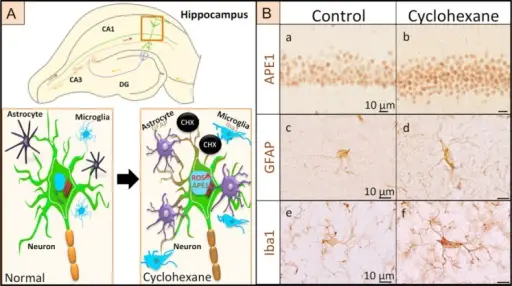
Glial response after hexahydrobenzene exposure.(A) Scheme of the effects of hexahydrobenzene (cyclohexane) in the mouse hippocampus. Astrocytes and microglia (in close proximity with pyramidal neurons at CA1 and CA3 hippocampal regions) help preserve local homeostasis and neuronal communication. Hexahydrobenzene inhalation increases the production of reactive oxygen species (ROS) and intracellular apurinic/apyrimidinic endonuclease 1 (APE1) that, in turns, provokes glial-cell activation to preserve the tissue microenvironment. (B) Morphological changes observed in the mouse brain after cyclohexane inhalation for 30 days: APE1 expression in the CA1 region of mouse hippocampus under control conditions (a). APE1 expression in the CA1 region mouse hippocampus after a 30-d cyclohexane inhalation (b). GFAP-expressing astrocytes under normal conditions (c). Reactive astrocyte (after cyclohexane exposure) displays cytoplasm swelling and high number of cytoplasmic processes (d). Iba1-expressing ‘resting’ microglia shows a stellate morphology: the small soma has a number of long and fine cytoplasmic processes (e). A reactive microglia cell showing hypertrophic branches after cyclohexane inhalation (f). Bars = 10 μm. Glial plasticity after hexahydrobenzene exposure.
Campos-Ordonez T, Gonzalez-Perez O - Neural regeneration research (2016). Not Altered. CC.
Microglia react to injury in many ways that include:
